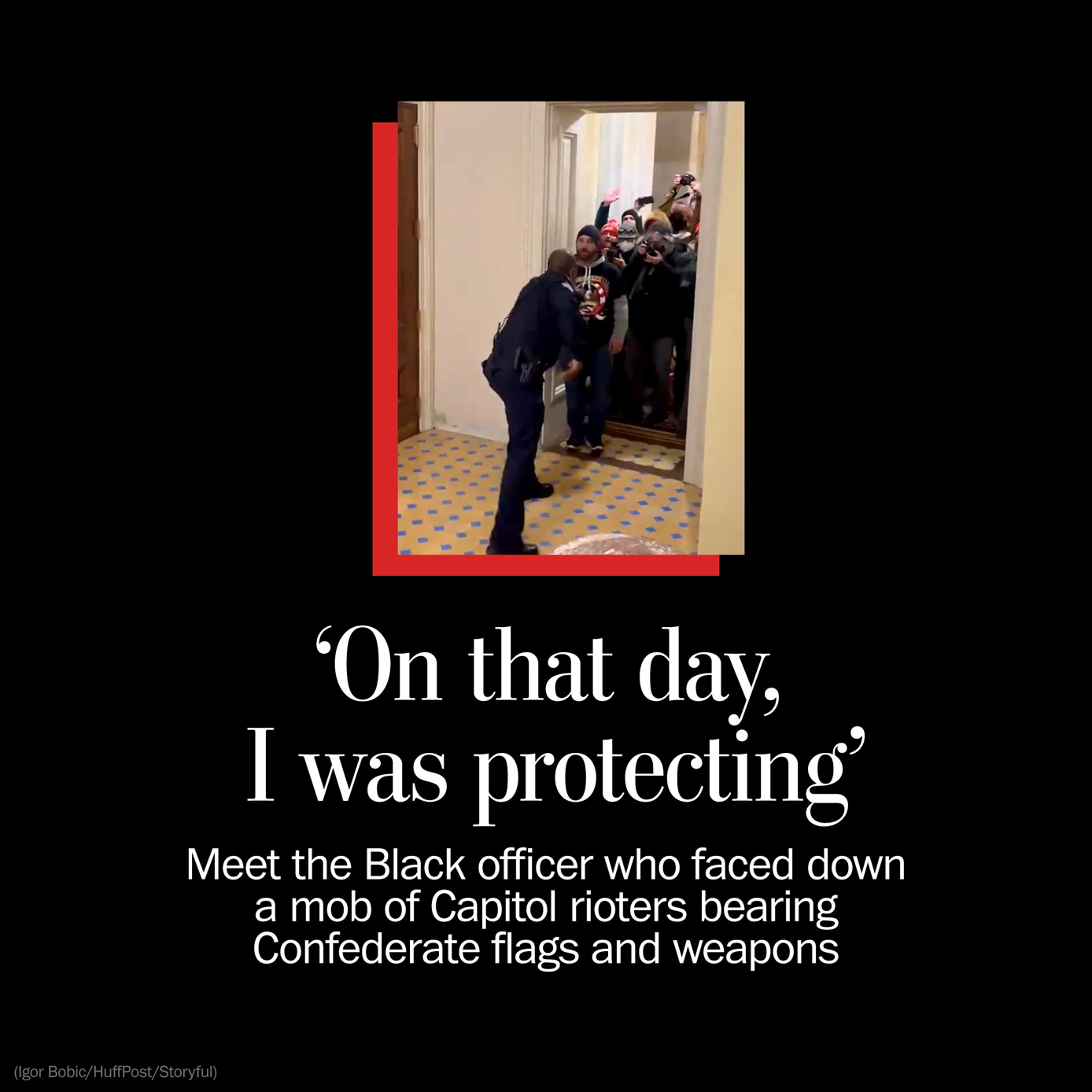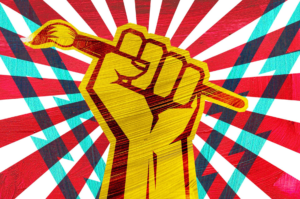It was a video clip that captured not only the terror of the day, but the values at stake: a lone Black police officer in the marble halls of the U.S. Capitol building, facing down a mob of mostly White rioters who had stormed in bearing Confederate flags, weapons and vows to reclaim a lost election.
The footage captured by HuffPost political reporter Igor Bobic has gone viral in the past week, spurring people across the world to hail the officer as a hero. The U.S. Capitol Police have not publicly identified him, but three of his friends told The Washington Post that the officer is Eugene Goodman of Maryland, confirming what journalists at CNN and elsewhere have reported.
For 85 tense seconds, Goodman tries to hold back dozens of rioters, twice retreating up a flight of stairs. Police experts say he wasn’t fleeing, but luring the mob away from the Senate chambers, where lawmakers were sheltering and armed officers — including one with a semiautomatic weapon — were securing the doors.
His actions likely preempted what could have been a violent confrontation, Kirk D. Burkhalter, a professor at New York Law School and a former New York City police officer, said in an interview.
The toll from the Jan. 6 attack — five deaths, including a Capitol Police officer, a protester shot by police and three who died of medical emergencies — could have been far higher if Goodman had made different choices, said Burkhalter, who reviewed the video at The Post’s request.
“These folks had zip ties,” he said, referencing images of the rioters holding zip-tie handcuffs that have emerged since the attack. “It’s not unreasonable to say that they were ready to take hostages. . . . Officer Goodman really helped to avoid a tremendous tragedy.”
Friends who have talked to Goodman since the riot, including two fellow officers and a former colleague, said he has been ambivalent about the limelight. Generally private and reserved, the D.C. native has started to worry about becoming a potential target of far-right extremist groups that have vowed to return to D.C. this weekend and for next week’s inauguration.
“He said he’d do the same thing again. He’s not looking for any accolades,” said one friend, a Capitol Police officer who spoke on the condition of anonymity because he had not been authorized to speak on the issue. “But the attention is a little scary for him.”
Neither Goodman nor a Capitol Police spokeswoman responded to requests for an interview.
Goodman, 40, grew up in Southeast Washington and served in the Army from 2002 to 2006, deploying with the 101st Airborne Division to Iraq for a year, said Cynthia Smith, a service spokeswoman. His awards include a combat infantryman badge, indicating he was in ground combat.
Those who know Goodman said his decision to lead the rioters away instead of directly engaging them reflects his military experience.
“He was diverting people from getting on the Senate floor and getting hostages. It was the smartest thing that he could have ever done,” his colleague said. “I don’t know that many people who can think on their feet like that. . . . His quick thinking enabled those senators to get to safety.”
A close friend of Goodman’s, who asked to be identified by his first name, Terry, out of fear of being targeted by far-right extremists, said the officer has a reputation for being a calm leader during emergencies.
“I’ve always said, if bullets start ripping through, I’m finding Goodman,” said the friend, who has spoken to Goodman several times since the incident. “He’s been in hostile firefights, so he knows how to keep his head.”
The most popular and interesting stories of the day to keep you in the know. In your inbox, every day.
Burkhalter, the New York professor, said Goodman appears in the video to be doing three tactical things simultaneously: leading rioters away from the Senate chambers, coordinating for backup on the second-floor landing, and exercising extreme restraint to prevent injury or loss of life.
In the first part of the video, when Goodman retreats up a flight of stairs, he only briefly turns his back to the rioters, Burkhalter notes. Most of the time, he’s backing away with his eyes toward the mob, suggesting that he is not running away from them but attempting to lead them somewhere. When Goodman reaches the second-floor landing, he glances to his left, where the entrance to the Senate chambers is located.
At this point, he makes a risky decision, Burkhalter said. He opens his collapsible baton — which had fallen on the floor earlier — and lightly pushes the man leading the mob of rioters, later identified as Douglas A. Jensen, 41, from Des Moines.
Jensen briefly looks toward the Senate chambers, then follows Goodman, who is walking in the other direction and toward backup. In an indictment unsealed Wednesday, prosecutors said Jensen told investigators he positioned himself at the front of the mob because he wanted his T-shirt, promoting the right-wing conspiracy-theory group QAnon, to be visible. He faces charges including trespassing, obstructing police during a civil disorder and resisting officers.
“In pushing him, the lead rioter, he’s attempting to get him to follow along,” Burkhalter said of Goodman. “He’s trying to bait them.”
Bobic, the reporter who filmed the video, said he realized days after the attack that the Senate doors were sealed just minutes before Goodman had lured the rioters away. “If they had just gone right instead of left,” Bobic said in an interview, the intruders might have reached the lawmakers.
Keith Taylor, a professor at John Jay College of Criminal Justice and another former New York City police officer who reviewed the video, said Goodman showed significant situational awareness. Even as he spoke and beckoned to the rioters, he was communicating with co-workers through a radio attached to his uniform, Taylor said, giving them updates on where he was and where he was headed.
By the end of the video, he appears to have led the rioters to another area, where several other officers were prepared for a standoff. The mob can be heard yelling at Goodman and the other officers and calling them “traitors.”
Goodman’s restraint is also notable, Burkhalter said, given the intruders had broken into the Capitol building, were predominantly White and bore symbols of the Confederacy. Many have since been identified as members of white-nationalist organizations and militant right-wing organizations, such as the Proud Boys.
Usually, Burkhalter said, when Black people are being stalked by White people with Confederate flags, it “doesn’t end up well for the Black folks.”
Terry, who is White, said he and Goodman have talked about race, and about the conflicts Goodman feels as a Black law enforcement officer. “For him, it’s always like, ‘I’m too Black for the badge, but too blue for the brothers,’ ” Terry said.
The video has drawn waves of praise for Goodman online. Ben Crump, the attorney for the families of George Floyd and Breonna Taylor, tweeted that Goodman should be awarded the Public Safety Officer Medal of Valor. Sen. Robert P. Casey Jr. (D-Pa.) said Congress “owes him a debt of gratitude.” And former Senate candidate Jaime Harrison, who challenged Sen. Lindsey O. Graham (R) in South Carolina, declared that Goodman’s “judgment & heroism may have saved our Republic.”
Bobic said that if he gets to meet Goodman, he’d like to convey the hundreds of thousands of messages he has received from people worldwide about the video. But he’d also like to thank him personally for protecting him.
“If he wasn’t there,” Bobic said, “I would have ran flat-footed into the mob.”
Goodman’s attitude toward his job has remained the same despite his newfound fame, his friends said, adding that during the attack, he was focused on defusing the threat to lawmakers, not his own safety.
“My job is to protect and serve,” he told co-workers after the video of him went viral. “And on that day, I was protecting.”
Dan Lamothe, Spencer S. Hsu and Jennifer Jenkins contributed to this report.




